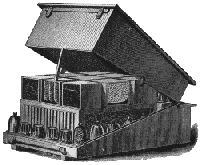Article first published as The Quest for The Perfect Hive on Technorati.
 Back in my Mom’s hippie days she subscribed to Mother Earth News and I was taken with the idea of finding 50 acres and living the Organic Life. One of my top interests was keeping bees. Over the years the idea of getting a bee hive has tickled my imagination, but I have never quite gotten around to it. Bees were big news not too long ago because of the mysterious affliction known as Colony Collapse Disorder-which seems to have been traced to the use of tobacco genes as a pest control measure in many crops. Bees don’t like tobacco.
Back in my Mom’s hippie days she subscribed to Mother Earth News and I was taken with the idea of finding 50 acres and living the Organic Life. One of my top interests was keeping bees. Over the years the idea of getting a bee hive has tickled my imagination, but I have never quite gotten around to it. Bees were big news not too long ago because of the mysterious affliction known as Colony Collapse Disorder-which seems to have been traced to the use of tobacco genes as a pest control measure in many crops. Bees don’t like tobacco.
Sherlock Holmes, the ultimate Victorian, famously retired from being a Consulting Detective to take up tending bees in Sussex. The Victorians had a bit of a fascination with bees and developed all kinds of extraordinary bee hives as a result.
The Quest for the Perfect Hive follows the history of bee keeping and many odd and unusual ways in which bees have been encouraged to put honey where people can get their hands on it.
The story travels from prehistoric cave painting to Egyptian tomes to European castles and finally to the wild frontier of America. There we find Lorenzo Langstroth, discoverer of the Bee Space of 3/8″ and inventor of the Langstroth Hive which was the forerunner for the modern commercial beehive.
Along the way we see the popularity of straw skeps-those little domes that often show up on bars of soap. Langstroth’s wooden hives were not an immediate success, though people did like the idea of easily removal frames. Since most of this innovation takes place between 1850 and 1910 there were all manner of hypercomplex bee hives being made using all those wonderful technologies created by The Industrial Revolution.
Just looking at the catalogue drawings of some of these hives is enough to give you a headache. One of the great aspects of The Quest for the Perfect Hive are all the old drawings and photographs that appear on just about every page. Among the many things I didn’t know was that there was a phase when glass was used to collect honeycomb and many hives of the day had bell jar accessories. The idea was that you could see when the jar was filled with comb and honey and then remove it. It was an easy matter to replace the filled bell jar with an empty one. What an idea. There is a photo of such a jar filled with comb the author used on one of his own skep hives.
As author Gene Kritsky wraps up The Quest for the Perfect Hive he talks about bee accessories and why the modern hive hasn’t changed all that much in the last hundred years or so. Seems that bee hives and honey extractors are expensive and no one wants to change the standardized sizes now in use. Too bad, I really loved the look of those Langstroth bee hives with glass bell jars and special rooms for comb to be grown.
- Starfield – A Few Months In - December 23, 2023
- Still Just A Geek by Wil Wheaton - November 1, 2022
- Starfield First Impressions of Gameplay Reveal - June 13, 2022

Bee keeping is a bit of work, and a bit of expense, but we find it well worth it. This year we are expecting to be able to take about 100 pounds of honey from our hives. Honey never goes bad; it is the only food with this characteristic. I resisted having bees in our yard; originally they were being kept off site at a second, larger garden, which we share with friends, but the first year we had bees at home, our raspberry production tripled. I’m a convert. Of course they are not pets that you can pat or cuddle with, but watching the traffic is fascinating.
Sheryl here, i was just wondering why my honey bees are growing weak. they were not as active as how they used to be. and im also having trouble with bee removal. im just a new bee keeper. can you help me out?